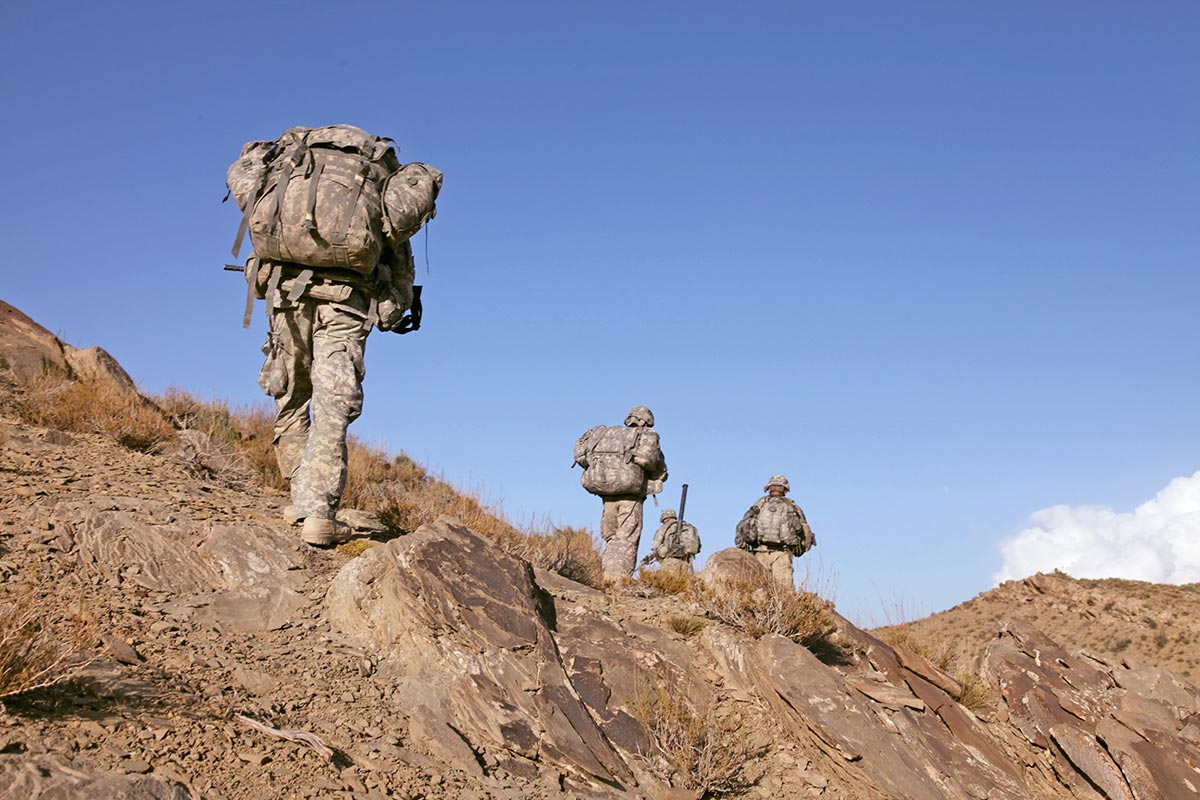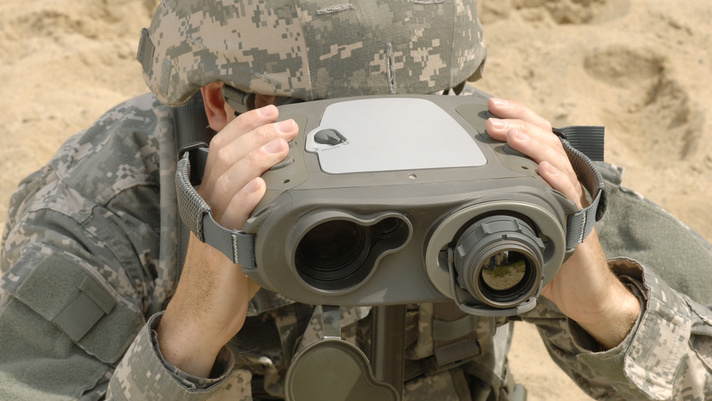U.S. Soldiers in the twenty-first century rely on some of the world’s most advanced equipment. From compact GPS systems that help them navigate unfamiliar terrain to precision laser devices capable of halting a threat without firing a shot, today’s gear blends innovation, practicality, and battlefield-tested engineering. Every tool exists for a reason, and every addition to the soldier’s loadout solves a real problem encountered somewhere in the field. What follows is an expanded look at some of the essential gadgets and systems American forces carry into modern operations.
AN/PSQ-20 Enhanced Night Vision Goggles

The AN/PSQ-20 Enhanced Night Vision Goggle, often called the ENVG, is a major leap forward in allowing Soldiers to operate confidently in low-light or visually challenging conditions. Unlike older systems that relied solely on image intensification, these goggles blend both intensification and long-wave infrared imaging into one helmet-mounted unit. That combination means Soldiers can see fine details in extreme darkness while also detecting heat signatures that cut through fog, dust, or thick foliage.
This dual-sensor capability gives the ENVG a level of versatility that earlier generations of night vision gear simply could not match. Soldiers can track movement through smoke, navigate in early morning mist, and spot hidden threats that would otherwise blend into shadowed terrain. The system also works during daylight hours, providing thermal contrast even when light conditions are normal.
The ENVG design includes thoughtful engineering improvements meant to support Soldiers during long missions. Placing the battery pack at the back of the helmet redistributes weight more evenly and reduces neck strain, making hours of wear more manageable. The device pairs seamlessly with ballistic eye protection and folds down compactly when not in use — a small but important upgrade that improves mobility when transitioning between environments.

This advanced goggle is built to perform in nearly any low-visibility scenario: heavy rain, swirling smoke, thick fog, blowing snow, or even battlefield dust. Its ability to merge thermal and non-thermal images allows Soldiers to maintain situational awareness when conditions change unpredictably. Whether navigating tight alleyways or scanning open fields, the system significantly boosts a soldier’s reaction time and accuracy.
Survival Kit Ready Access (SKRAM)

The Survival Kit Ready Access Modular — known as SKRAM — is a highly organized emergency system designed for escape-and-evade situations. When a Soldier becomes isolated from their unit or forced into an emergency landing, the SKRAM provides the critical tools needed to stay alive and functional until rescue arrives. Inside the kit are life-support essentials such as purified water, compact food supplies, survival ammunition, water filtration tools, sterile equipment, and a lightweight field sleeping setup.
The SKRAM is flame-resistant and built as a modular backpack with two separate “Go Bags.” One bag is assigned to each crew station and includes Aviation Life Support Equipment tailored to the region of operation — for example, extra hydration supplies in desert environments. The second Go Bag is issued to each crewmember individually and contains mission-specific items like personal survival gear, additional M4 ammunition, and components of the Army’s Modular Sleep System.
These kits are engineered to be easily accessible in emergencies, allowing Soldiers to grab both bags quickly during chaotic situations. The modular design also means units can adapt their kits depending on climate, mission type, or expected threats, giving troops a measure of flexibility that older survival systems lacked.
Modular Lightweight Load-Carrying Equipment (MOLLE)

The Modular Lightweight Load-Carrying Equipment system — commonly called MOLLE — is the backbone of modern soldier load management. This adaptable carrier system holds the full range of mission-essential equipment a Soldier needs in the field. MOLLE is built on the idea of modularity: instead of a fixed design, it uses a grid of durable webbing that allows each Soldier to attach pouches, tools, ammunition carriers, hydration systems, and other gear exactly where they need it.
The system connects to releasable body armor through the Tactical Assault Panel (TAP). The TAP includes integrated pockets for six standard magazines, a radio, and GPS. Additional MOLLE pouches can be attached wherever required based on the soldier’s mission. This is especially important because different roles — rifleman, grenadier, medic, automatic rifleman — require unique loadouts.
The MOLLE rifleman set includes the 2,000-cubic-inch Assault Pack for short missions, while the medium ruck provides 3,000 cubic inches of storage for 72-hour operations. For long-duration deployments, the large rucksack expands the system to a full 4,000-cubic-inch pack capable of carrying sustainment gear, cold-weather equipment, and mission-specific tools.
This customization ensures that every Soldier can configure their load efficiently, balancing mobility, protection, and accessibility in a way that matches the realities of modern combat.
TARGET RECONNAISSANCE INFRARED GEOLOCATING RANGEFINDER (TRIGR)

The Target Reconnaissance Infrared Geolocating Rangefinder — known as TRIGR — is a powerful handheld or tripod-mounted device that allows Soldiers to identify and locate enemy targets with extraordinary precision. For ground forces needing exact coordinates while dismounted, TRIGR provides mission-critical target data at ranges exceeding two miles.
Using a combination of infrared sensors and laser-based ranging technology, the system performs effectively in daylight, nighttime, and obscured-visibility situations such as fog, smoke, and atmospheric dust. The device condenses multiple older systems into a single lightweight package, dramatically reducing the burden Soldiers once faced when carrying separate thermal imagers, laser rangefinders, and GPS units.

Meeting the Army’s strict LTLM (Laser Target Locator Module) requirements, the TRIGR underwent rigorous environmental testing, including winter trials at Fort Greely, Alaska. Engineers faced brutal winds, subzero temperatures, and limited daylight during testing but gathered the data needed to ensure reliable real-world performance. More than 5,000 units have been fielded since 2010, and despite newer technologies emerging, TRIGR devices are expected to remain operational well into the 2030s.
Its ruggedness and precision make it invaluable for reconnaissance teams, forward observers, and any Soldier requiring exact coordinate data before calling for indirect fire or coordinating air support.
Microclimate Cooling System

The Microclimate Cooling System is a specialized setup designed to protect helicopter aircrews and vehicle operators from intense heat stress, especially when missions require them to wear chemical or biological protective gear. Aircraft interiors and armored vehicles can become extremely hot during operations, and protective suits trap additional body heat. This system helps counter that problem by delivering consistent cooling directly to the person wearing it.
At the core of the system is the Vehicle Compressor Cooling System, often referred to as the BCCS. It relies on a compact liquid chiller connected to a lightweight cooling vest. Cold water circulates through channels inside the vest, powered by a small electric pump. As the chilled water moves across the torso, it draws heat away from the body, keeping crew members functional even in harsh temperatures.
The system delivers a cooling capacity between 250 and 360 watts and runs on vehicle power. It’s built to integrate into a wide range of platforms, from helicopters and armored vehicles to military trucks. The vest itself is designed for comfort and durability, and it can be washed using a protective laundry bag to preserve the internal tubing. Because it doesn’t require ice, the system is ideal for extended missions in hot climates where resupply may not be possible.
Its applications go beyond helicopters — tank crews, naval personnel, pilots, and even racing drivers in extreme environments have benefited from similar cooling technology. By reducing heat stress, the Microclimate Cooling System helps maintain alertness, reaction time, and decision-making ability, all of which are critical during long or high-intensity missions.
GREEN LASER INTERDICTION SYSTEM

The Green Laser Interdiction System, or GLIS, is a non-lethal laser device designed to safely halt or redirect potential threats without the need to fire a weapon. Mounted on a rifle or used as a handheld device, it projects a highly visible green laser beam capable of gaining attention instantly, even at long distances. This makes it invaluable for situations where warnings must be unmistakable — such as at checkpoints, during patrols, or when civilians unknowingly approach a restricted military area.
The GLIS allows Soldiers to disrupt hostile actions by visually overwhelming the target, causing immediate hesitation or withdrawal. This effect is especially important in tense environments where Soldiers must distinguish between genuine threats and civilians who may simply be unaware of their surroundings. The system fills the gap between verbal warnings and lethal force, giving operators a reliable tool to control escalation.
Its uses span multiple mission types, including force protection, maritime security, entry control points, and crowd or vessel redirection. Whether mounted on a handheld weapon or fixed to a crew-served platform, the device maintains consistent performance with visible effects from zero to roughly 300 meters.
Because it is non-lethal, the system is often used to guide individuals away from dangerous areas, warn approaching vehicles, or signal potential threats without putting innocent lives at risk. The GLIS reduces uncertainty during operations by providing a clear and immediate visual cue that is almost impossible to ignore — an important advantage in high-stress environments.






